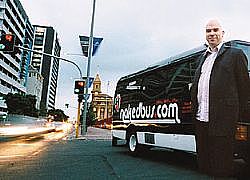Capitalising on diversity
The capital region has evolved into one of this country’s most dynamic business economies. Warwick Halcrow filed this report.
The capital region has evolved into one of this country’s most dynamic business economies. Warwick Halcrow filed this report.
On a return flight from the capital recently an Auckland business executive was heard to remark that “Wellington has the greatest evolution power in the country.”
From the bureaucratic 80s and painful restructuring of the 90s the Wellington region has evolved into a dynamic place to do business in the new millennium. Today’s buzzwords for this vibrant region reflect the new economy – creative, innovative, artistic, intelligent, stylish and successful.
The Government sector has always been a major driver but when it comes to business in Wellington today there is much more to it as the recent high profile, multi-million dollar buy-outs of TradeMe, 42 below and Caffe L’Affare prove.
These and many other business success stories began life as upstart start-ups in the ‘Windy City’ and it’s happening throughout the whole Wellington region.
Positively Wellington Business (PWB), the business development agency for the region, combines the strengths of Wellington City, Hutt City, Upper Hutt, Porirua and Kapiti Coast. Established in 2001 through a realisation that there is economic strength in unity PWB’s mission is to attract, foster and promote new and established businesses particularly in the region’s strongest performing industries: business and consulting services, film and TV, information communication technology, creative manufacturing, biotechnology, education and tourism.
These industries can best capitalise on the region’s key strengths – a highly educated work force, the most advanced broadband system and greatest concentration of expertise in the country, combined with a growing interface between government, private enterprise and world class education and research facilities.
Easy access to New Zealand’s busiest domestic airport, less traffic congestion, booming retail and tourism sectors, and a lifestyle rated as “the worlds twelfth best place to live” in Mercer’s 2006 ‘Quality of Living Survey’ creates a very attractive regional environment says PWB CEO Phil Lewin.
“It’s all about presenting a bigger value proposition to the rest of New Zealand and the rest of the world. It means having strength through diversity, showing different expertise around the region, making it more attractive to businesses, foreign investors and trading partners.
“It’s not about becoming ‘the widget capital of New Zealand’ or becoming one entity,” says Lewin. “It’s about promoting the diversity available.”
The offering for business is about to get even bigger with the development of a new Wellington regional business and economic strategy that includes the neighbouring Wairarapa region.
The new economy
Lewin believes Wellington is a great place for small business.
“Today’s relationship with central government is symbiotic and many firms enjoy Government as one of their main clients. But the prevalent shape of Wellington business today is small, fast on its feet, creative and in many cases earning margins way over their size. Many are doing well in the international sector.”
A unique advantage of a capital city is having a concentration of knowledge workers and an advanced ICT industry says Lewin.
It’s very much in the creative, knowledge derived and services economy – anything that involves the application of ideas and creativity into product form. Often these [products] are not the sort you load on a ship but deliver to an overseas client via cable.
“We are working with high growth potential companies that, with the right assistance, will get up to a much higher level – it’s exactly what the whole economy needs,” adds Lewin.
Clusters and incubators
The ‘working together’ strategy that created PWB has become an integral part of the regional business development plan and has seen the formation of eight cluster groups – each capitalising on local expertise in export growth industries.
“The whole point of a cluster, as opposed to a network, is to get companies working together on specific export projects,” Lewin explains.
“A celebrated example is the earthquake strengthening of buildings in Turkey by a consortium of six Wellington companies led by Beca Carter that also involved smaller businesses.”
In December 2006, the Earthquake Engineering Cluster succeeded in winning another contract to review Romania’s earthquake building and strengthening code. And Lewin reports that the other cluster groups are also producing great results.
Another key strategy developed by PWB is the ‘Creative HQ’ and ‘Fashion HQ’ initiatives – business incubators that provide selected creative start-up businesses with a full range of business support services and quality infrastructure in a subsidised environment for up to two years.
Currently there are 14 resident companies in the incubators and eight graduate companies are now successfully making their own way out in the business world.
Export potential
The Wellington Regional Chamber of Commerce recently celebrated its 150th anniversary. Chief executive Charles Finny reports “that while the growth of the ‘new economy’ is fantastic, there needs to be a greater focus on growing the existing economy and retaining established businesses in the region.”
“We want the new regional strategy to focus strongly on this.”
The possibility of Telecom relocating its new CEO and head office is a current example, says Finny.
“Central government’s huge impact on the local economy is a mixed blessing,” he says.
“Many businesses benefit enormously but it is putting big pressure on the private sector by driving up wages and rentals. A lot of talent is attracted to government creating competition in the market place.”
Finny points out that while the established business sector in general is doing well there are significant opportunities for growth and therefore retention of successful companies.
“There is enormous potential for a number of the processes undertaken by government and the associated IT developed to be exported to the world. Right now there are no incentives to encourage this to happen.
“Government entities need to operate on a more business-like footing. There needs to be more collaboration between government, academia, research institutes and the private sector.”
Fortunately there are signs that this is already happening, says Finny.
“Airways Corporation and the Met Service are good models – both very successful exporters and collaborators with the private sector. That model needs to be transplanted throughout the wider public sector.”
The clusters developed by PWB are very positive steps towards this he says.
“Other significant opportunities include developing a centre of excellence for biotechnology around the former Ag-Research facility at Wallaceville. All the countries in the Pacific will want to do bio-security research and this could be carried out here.”
Finny says that economic growth in the Wellington region has been consistently steady at around two percent per year for some time and there is real potential to double that.
“Wellington is a very efficient place to do business with a very efficient port, workforce and broadband systems. We are closest to the rest of the country and Australia and if we deliver on all the infrastructure that is in the pipeline we will become an even more efficient place.”
Throughout the whole region, there is an enlightened drive to evolve business further as the following selected overviews prove:
• The Cultural Capital. Wellington City,
ranked as “a city on the rise” in Lonely
Planet’s Blue List 2007, is capitalising
on its tourism potential. A myriad
of major events and cultural attractions
combined with a seductive television
and magazine advertising campaign
has propelled Wellington forward to be
one of the top destinations in the
country.
• Upwardly mobile Upper Hutt. With a
rapidly growing biotechnology
capability, the establishment of the new
Defence Headquarters at Trentham and
a revitalised city centre, Upper Hutt is
poised for significant growth.
• Educated Hutt City. Adding to Weltec
and The Open Polytechnic the recently
opened ‘Greater Wellington Industry
Development Centre’ reinforces Hutt
City’s educational strength particularly
for the growing local ‘creative’
manufacturing industry.
• Porirua re-invented. Described as
“the future face of New Zealand” Porirua
has evolved into a vibrant, diverse,
multi-cultural city where education,
innovative manufacturing, distribution,
significant retail development and
cultural tourism are all thriving.
• Kapiti-Horowhenua set to fly. Nature
Coast is using the cluster strategy to
revitalise the fashion and textile industry
through a new company ‘Design Tec’
that combines 16 businesses into one
entity able to compete on a larger scale.
A new Centre of Excellence for the industry is planned; and the proposed redevelopment of Paraparaumu Airport will create significant growth opportunities in manufacturing, distribution and local employment. NZB
Warwick Halcrow is a freelance writer based on the Kapiti Coast.
Email [email protected]





